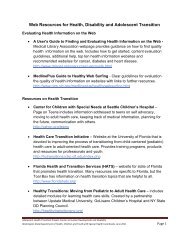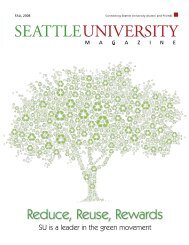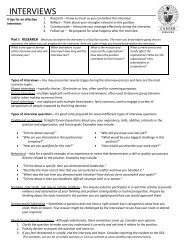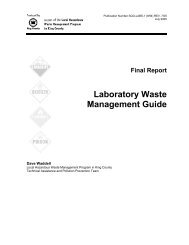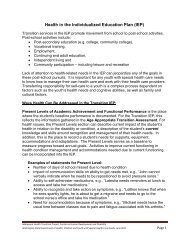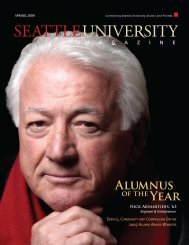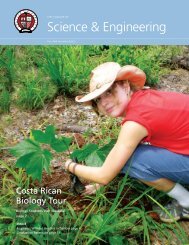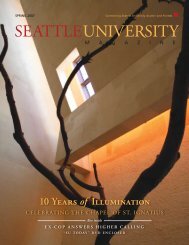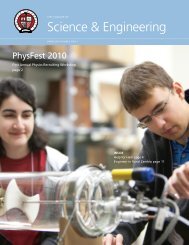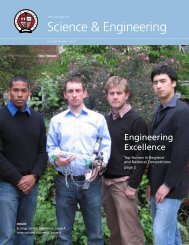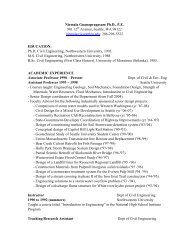2012 Spring - Science & Engineering Newsletter - Seattle University
2012 Spring - Science & Engineering Newsletter - Seattle University
2012 Spring - Science & Engineering Newsletter - Seattle University
Create successful ePaper yourself
Turn your PDF publications into a flip-book with our unique Google optimized e-Paper software.
The College of<br />
<strong>Science</strong> & <strong>Engineering</strong><br />
SPRING <strong>2012</strong> VOLUME 11 ISSUE 1<br />
Washington’s<br />
Professor<br />
of the Year<br />
Dr. Vicky Minderhout<br />
page 7<br />
INSIDE<br />
25th Anniversary of Project Center<br />
page 2<br />
Studying Wave Energy in Chile<br />
page 4
2 <strong>Science</strong> & <strong>Engineering</strong> seattle university 3<br />
Project Center Celebrates Silver Anniversary<br />
History of the Project Center<br />
Electrical engineering seniors Michael Parks, Joseph McIntosh, Arihant Jain, and Charles Park are designing a truck noise cancellation system for Kenworth.<br />
How do you get a job without experience, and how do you get experience without a job?<br />
The Project Center is <strong>Seattle</strong> <strong>University</strong>’s answer to this perennial question.<br />
Before graduation, every senior in engineering and computer<br />
science and every master of software engineering student joins a<br />
team of fellow students that completes a professionally sponsored<br />
design project. Through the generous support of our project<br />
sponsors, our students gain valuable real-world skills: coping<br />
with shifting project scopes, managing limited budgets, meeting<br />
real deadlines, and overcoming personnel issues. They learn the<br />
nuances of negotiation, public speaking, scheduling, and<br />
matching engineering design with the bottom line.<br />
The practical utilization of skills discussed in the classroom,<br />
when linked to the Jesuit mission of service to others, can bring<br />
dramatic changes to people’s lives, and our Project Center has a<br />
long tradition of doing public service projects. Here are just a<br />
few examples: project teams have travelled to Nicaragua to help<br />
coffee farmers improve the processing of their crops, to Zambia<br />
to build a waterwheel to pump water away from a crocodileinfested<br />
river, and to Haiti to help provide arable land to a hungry<br />
populace.<br />
The Project Center has become an indispensable element of our<br />
engineering program. We are proud that our student project<br />
teams regularly win national awards for their work and that<br />
many of their project designs find their way into commercial<br />
products. We celebrate our alumni who volunteer their time to<br />
return to the program as sponsors and team liaisons. We are<br />
grateful that project sponsors, large and small, have chosen to<br />
join with us in shaping the next generation of engineers. ■<br />
by Bob Heeren and Jean Jacoby<br />
Over 25 years ago, three forward-thinking engineering chairs,<br />
Dale Carlson (CE), Robert Hereen (EE), and Dennis Wiedemeir<br />
(ME), envisioned an industry-sponsored engineering research<br />
center housed in the School of <strong>Science</strong> and <strong>Engineering</strong>, as it<br />
was called back then. The center would support design projects<br />
as the focus of engineering seniors at <strong>Seattle</strong> U. It was an innovative<br />
proposal. From this brainstorming emerged the <strong>Engineering</strong><br />
Design Center (EDC), precursor to the Project Center, authorized<br />
by Dean Terry van der Werff and officially initiated during the<br />
1987-1988 academic year.<br />
Professor Rolf Skrinde, Founding Director of the EDC, recalls “I<br />
was fortunate in … being associated with the Center in its early<br />
years, and in working with industry and faculty members to provide<br />
our graduating seniors with a taste of the real world of<br />
professional practice in which they were about to enter. Sometimes<br />
called a capstone experience, the Project Center was a relatively<br />
new concept at the time, but now there are many such programs<br />
at colleges and universities throughout the country. As Director,<br />
… much of my work relat(ed) to introducing the concept to<br />
industry and soliciting from them the types of projects that<br />
could be accomplished by teams of students, who … would<br />
dedicate approximately one quarter of their time during the<br />
senior year to the program.” Subsequent directors have carried<br />
on this tradition (Patricia Daniels, Jeff Gilles, and Jean Jacoby).<br />
For 15 years, the Project Center was supported by Sheridan<br />
Botts. In 2007, Amy Haedt took over project recruitment, sponsor<br />
relations, and contract management. Forging and maintaining<br />
these relationships with the sponsors is critical to the ongoing<br />
success of the program.<br />
Believing that the primary function of engineering is design, the<br />
three engineering departments integrated the professional<br />
practice of engineering into the senior design experience to give<br />
engineering students an opportunity to apply their knowledge<br />
in solving real-world problems. The current structure remains<br />
largely unchanged from its early days. Through a yearlong<br />
sequence of courses, student teams work to complete projects<br />
sponsored by corporate, government, or non-profit agencies.<br />
Project teams are composed of 3-5 students, a faculty advisor,<br />
and a liaison engineer from the sponsor. Seniors in computer<br />
science and graduate students in the Master of Software <strong>Engineering</strong><br />
program joined the program in 1996. In 2008 the Project<br />
Center formed a partnership with the Albers School of Business<br />
and Economics, enabling a common project recruitment base,<br />
cooperative projects, and interdisciplinary student learning. This<br />
Mechanical engineering seniors James Krumwied, Inri Haryono and Erika<br />
Tyler proudly display their senior design project, “Design of Algae Photobioreactor.”<br />
The sponsor wished to explore the possibility of using CO2<br />
from power plant exhaust to grow algae for biodiesel production.<br />
experience can also lead to student internship opportunities.<br />
As we look back over a quarter of a century, we note that this<br />
senior design experience is foundational for the engineering<br />
and computer science programs in the College of <strong>Science</strong> and<br />
<strong>Engineering</strong>. We have created an experience that trains engineering<br />
students to do design work at an advanced level, and<br />
we have maintained a strong relationship with highly satisfied,<br />
repeat sponsors (e.g., The Boeing Company, AREVA/Alstom<br />
Grid, Kenworth Truck Company, PACCAR, Puget Sound Energy,<br />
<strong>Seattle</strong> City Light, and <strong>Seattle</strong> Public Utilities). The Project Center<br />
has become a signature program of <strong>Seattle</strong> U. ■<br />
PROJECT CENTER SPONSORS 1987-<strong>2012</strong><br />
A. K. Gordon & Assoc. + Adobe Systems + Alliant Techsystems + Alstom + Amazon + AMEC + Appia <strong>Engineering</strong> Consultants + Appian Graphics + Applied Microsystems +<br />
AREVA T&D + ARIS + Artisan Instruments + Atigeo + AVTECH + Bass Educational Services + Better Lifestyles + Bioalgene + The Boeing Company + Center for Design of Analog-<br />
Digital Integrated Circuits + Cingular Wireless + Citrix Systems + City of <strong>Seattle</strong> + Consolidated Metco + Costco + Coughlin Porter Lundeen + Cray + Cybergroup + Data I/O<br />
Corp. + David Evans and Assoc. + David Taylor Research Center + City of Des Moines + DevDac + Duet Cascade + ELDEC + Electroimpact + Emerald City Rotary Club +<br />
Enchanted Learning + Engineered Software + Engineers Without Borders + Fluke + Fred Hutchinson Cancer Research Center + Friends of Blackman Lake + FSI + Group Four +<br />
GT Development + Harris Group + Harrison Comfort Footwear + HDR <strong>Engineering</strong> + Herrera Environmental Consultants + Hewlett-Packard + Honeywell + IEEE + Industrial<br />
Revolution + Ingersoll-Rand + Intelligent Results + K2 + Kenworth + King County + Leadership Advancement Int’l. + Magnusson Klemencic Assoc. + Management Assistance<br />
and Concepts + Medtronic Physio-Control + Microscan Systems + Microsoft + National Bureau of Asian Research + National Park Service + Neighborhood House + Nesting Bird Yurt<br />
+ Noetix + Nordstrom + Nova Ray + Nutraceutix + Octaform + PACCAR + Pacific Northwest National Laboratory + PACLAND + Parsons Brinckerhoff + PATH + Philips Healthcare<br />
+ Photon Machines + Pierce County + Port of <strong>Seattle</strong> + Potters for Peace + Pratt & Whitney + PSF Mechanical + Puget Sound Energy + Qwest + Rabanco + Regence BlueShield<br />
+ REI + The Robbins Company + Saint James Cathedral + Schweitzer <strong>Engineering</strong> Laboratories + <strong>Seattle</strong> City Light + <strong>Seattle</strong> Lighthouse for the Blind + <strong>Seattle</strong> Public Utilities +<br />
<strong>Seattle</strong> <strong>University</strong> + Siemens Medical Solutions + SignalSet + Snohomish County Public Works + Solution Recovery Services + Sound Transit + Spinoza Technology + SRAM + SRS<br />
Energy + SunGard Collegis + SvR Design + Terabeam + Tetra Tech KCM + The Other Roadside Attraction + Tinnea & Assoc. + Triad Assoc. + Two Degrees Consulting + Univar<br />
USA + Universal Avionics System + <strong>University</strong> of Washington + US Army Corps of Engineers + US Bureau of Reclamation + US Coast Guard + US Forest Service + US Public Health<br />
Service + Valberg + Verizon + Vietnam Veterans of America + Washington Mutual + Washington Publishing Company. + Washington State Department of Transportation +<br />
Washington State Ferries + Waste Management + Waterfront Construction + Wave Consulting Group + Wellness by Design + Westinghouse Hanford + Weyerhaeuser + Willapa<br />
Hills Farmstead Cheese + Wire DynamiX + WISDM + World Bicycle Relief + Xilinx + Zetec
4 <strong>Science</strong> & <strong>Engineering</strong> seattle university 5<br />
Message from the Dean<br />
I was having coffee in the<br />
Learning Commons a couple<br />
of days ago when Rodney<br />
Dwyer, a senior in mechanical<br />
engineering, came up to<br />
me to thank me for helping<br />
make possible his study<br />
abroad in Santiago, Chile.<br />
Rodney said it was a powerful<br />
experience, particularly<br />
the visit to the Memory and<br />
Human Rights Museum.<br />
Dr. Michael J. Quinn, Dean<br />
Later that day, I met with Dr. John Carter, who organized<br />
the trip, which was the capstone experience of a new<br />
elective course John created on the mathematical modeling<br />
of wave-energy extraction. Eight students from electrical<br />
engineering, mechanical engineering, and mathematics<br />
attended lectures, did homework, and took exams here<br />
in <strong>Seattle</strong> during winter quarter, then traveled with John<br />
to Chile during spring break to hear a series of lectures<br />
on the subject organized by Dr. Rodrigo Cienfuegos of the<br />
Pontifical Catholic <strong>University</strong>. When John and his students<br />
weren’t attending lectures or visiting laboratories, they<br />
were immersing themselves in Chilean culture. What a<br />
great example of one faculty member’s expertise and<br />
hard work resulting in an incredibly rich experience for a<br />
group of students!<br />
Faculty are at the heart of every university, and creative<br />
and enterprising faculty members like John Carter help<br />
make the College of <strong>Science</strong> and <strong>Engineering</strong> an extraordinary<br />
learning environment for our students. New faculty<br />
members bring new energy and ideas to the College, and<br />
for that reason I’m thrilled to report that we have hired<br />
seven new assistant professors who will begin in the fall<br />
of <strong>2012</strong>: three in biology, one in chemistry, and three in<br />
mathematics. I am confident they will have an immediate<br />
impact. For one thing, they will represent 1/9th of the<br />
total number of professors in the College. For another<br />
thing, they are an extraordinarily talented and accomplished<br />
group of people. Altogether, these seven new<br />
faculty members have already published more than 50<br />
refereed articles, many in highly respected journals, including<br />
Nature and <strong>Science</strong>.<br />
As we continue to attract remarkable faculty members<br />
who have a genuine interest in working with students<br />
and fostering their professional formation and personal<br />
growth, <strong>Seattle</strong> <strong>University</strong> will become an even more<br />
attractive destination for science and engineering students,<br />
catalyzing an exciting new era in our College’s history. ■<br />
www.facebook.com/seattleuscieng<br />
Faculty and students pose at La Estación Costera de Investigaciones Marinas,<br />
a facility of the Pontifical Catholic <strong>University</strong> of Chile (PUC) on the bluff in La<br />
Cruces, on the Chilean coast. From left to right: Juan Carlos Dominguez (PUC),<br />
Caleb Bowman, Erin Shankel, Max Cerami, Maricarmen Guerra (PUC), Aaron<br />
Klingensmith, Emily Frost, Dr. Rodrigo Cienfuegos (PUC), Adam Frank, Dr. John<br />
Carter, Kia Braha, Rodney Dwyer, and Dr. Cristian Escauriaza (PUC).<br />
Energy from Waves:<br />
International Study in Chile<br />
As part of the winter quarter course, “Mathematical Models of<br />
Wave-Energy Extraction,” Dr. John Carter and eight SU students<br />
traveled to Santiago, Chile, for spring break. These lucky students<br />
participated in a series of lectures on ocean and tidal energy<br />
extraction in this extraordinarily rich environment. The course<br />
was organized by Dr. Rodrigo Cienfuegos at the Pontifical Catholic<br />
<strong>University</strong> of Chile. Chile’s immense coastline and dramatic<br />
energy needs affords excellent opportunities to explore harnessing<br />
tidal and wave energies. Dr. Cienfuegos and his research group<br />
are internationally known for being at the forefront of wave and<br />
tidal energy extraction. (Following this course, Dr. Cienfuegos<br />
flew to Sendai, Japan, for a conference on tsunamis.)<br />
While the trip included a visit to the Department of Hydraulic<br />
and Environmental <strong>Engineering</strong> at PUC and research facilities in<br />
Santiago and Las Cruces, students also dedicated time to experiencing<br />
Chilean culture. They visited a number of museums,<br />
including the incredibly powerful Museum of Memory and<br />
Human Rights, and spent several afternoons enjoying Santiago’s<br />
lovely parks. They ate Chilean delicacies including pastel de choclo,<br />
chorripan, and chorrillanas and drank pisco sours, Chilean<br />
wines, and fresh-squeezed juices from a wide variety of fruits. A<br />
highlight of the trip was the asado (Chilean BBQ) at Rodrigo’s<br />
house.<br />
The opportunity for engineering and mathematics students to<br />
study with this renowned Chilean team is inestimable. As future<br />
generations strive to deal with energy shortages and the options<br />
afforded by renewable energy sources, this experience will<br />
shape these students from <strong>Seattle</strong> U. ■<br />
Alumni News<br />
On April 17th, physics alumnus<br />
Paul Newman ‘78 received the<br />
Alumni Board’s Professional<br />
Achievement Award. Dr. Newman<br />
is a leader in the use of aircraft for<br />
atmospheric research and is the<br />
Chief Scientist for Atmospheric<br />
Chemistry at NASA’s Goddard<br />
Space Flight Center in Greenbelt,<br />
Maryland. Newman has authored<br />
Paul A. Newman, Ph.D., ’78<br />
or co-authored more than 130<br />
refereed scientific papers and<br />
reports, including several significant studies of atmospheric<br />
ozone. He helps direct Goddard’s analysis of the dynamics,<br />
chemistry, and radiative properties of the middle atmosphere.<br />
Newman currently serves as co-chair on the Scientific Assessment<br />
Panel to the Montreal Protocol, a landmark international<br />
treaty banning ozone-depleting substances. He directed the<br />
first flight of the NASA ER-2, a civilian version of the U-2<br />
converted to scientific research. He has been named in ten<br />
NASA Group Achievement awards and been twice chosen by<br />
his Goddard colleagues for peer awards. Newman grew up in<br />
St. Joseph Parish on Capitol Hill, <strong>Seattle</strong>. Several members of<br />
the Newman family are also SU graduates, including his late<br />
father Jerome ’58, daughter Mary ’02, brother Stephen ’81,<br />
and sister Joyce (Griffin) ’80. The day before receiving the<br />
Alumni Award, Dr. Newman addressed <strong>Seattle</strong> U students<br />
on the impact of ozone-depletion and efforts to curb this<br />
degradation.<br />
John Hooper, P.E., S.E., is Principal<br />
and Director of Earthquake <strong>Engineering</strong><br />
at Magnusson Klemencic<br />
Associates (MKA), an international<br />
award-winning <strong>Seattle</strong>-based<br />
consulting structural and civil<br />
engineering firm. John graduated<br />
from <strong>Seattle</strong> U in 1981 with a BCE<br />
and joined Ratti Fossatti Associates.<br />
He attended UC Berkeley in<br />
John Hooper, P.E., S.E., ‘81<br />
1983, earning his MS in 1984,<br />
re-joining RFA that year as Technical<br />
Director. In 1990 he became a Principal/Partner. In 1997, John<br />
moved to MKA. An MKA owner for over 12 years, John has<br />
been integral in directing the firm’s technical undertaking, focusing<br />
on seismic and earthquake engineering, particularly<br />
in the research and development of new codes, methodologies,<br />
and approaches. Through project and technical committee<br />
experience, John remains at the forefront of industry advancements.<br />
He is the Chair of the American Society of Civil<br />
Engineers’ Seismic Subcommittee, member of the NEHRP<br />
Advisory Committee on Earthquake Hazards Reduction<br />
(ACEHR), and very involved with the Earthquake <strong>Engineering</strong><br />
Research Institute (EERI), FEMA, and the Pacific Earthquake<br />
<strong>Engineering</strong> Research (PEER) Center. John serves on the College<br />
of <strong>Science</strong> and <strong>Engineering</strong> Advisory Board.<br />
On February 9th, alumnus Charlie Lyford visited with mechanical engineering<br />
majors to offer practical design and implementation advice.<br />
Students Evan Sjostedt, Max Cerami and (hidden) Rick Frederick take<br />
advantage of Lyford’s professional experience.<br />
Alumnus Charlie Lyford ‘96 visited the campus in February<br />
and provided a lot of practical advice to the ASME Student<br />
Club that is designing a one-seat electric car. He has often<br />
helped with go-kart and bike “design and build” projects,<br />
lending his expertise and welcoming students to his state-ofthe-art<br />
race car lab, T-Zero. Charlie has generously donated<br />
equipment to the College’s machine shop, allowing engineering<br />
students to gain valuable machine tool experience. The Lyford<br />
family, including Mary ’12, has three generations of professional<br />
motor sport racing experience. They are passionate about<br />
hands-on engineering.<br />
Upcoming Events<br />
<strong>Science</strong> and engineering majors will participate in the<br />
Celebration of Student Scholarship on Friday, May<br />
18, from 9:00 a.m. to 4 p.m. in the Student Center.<br />
<strong>Engineering</strong> and computer science students will<br />
present their work at the 25th annual Projects Day on<br />
Wednesday, May 30. This year’s celebration will begin<br />
at 1 p.m. in the Pigott Auditorium.<br />
The College will host a large booth at the <strong>Seattle</strong><br />
<strong>Science</strong> EXPO at the <strong>Seattle</strong> Center, Saturday, June 2,<br />
10 a.m. – 6 p.m.<br />
All three of these events are free and open to the public.
6 <strong>Science</strong> & <strong>Engineering</strong> seattle university 7<br />
Bannan Scholar Profile: Nichole Porter<br />
I grew up in a family where education<br />
was not considered important,<br />
so I dropped out of high school in<br />
9th grade, like my parents. As an<br />
adult I took dead end jobs, living<br />
paycheck to paycheck. When I was<br />
22 I married and soon had my son,<br />
Quinton, and daughter, Alexandra.<br />
I became a stay-at-home mom with<br />
a smaller income.<br />
Just after I had my daughter, my best friend passed away suddenly.<br />
Like me, she also had a three-year-old. I was heartbroken<br />
but began to wonder, “If I were to pass away, what would my<br />
children have from their mother? What would I like them to inherit<br />
from me?”<br />
I did not want them to struggle as I had, and I knew that the<br />
way to change that was for me to return to school, to lead by<br />
example. This would make it possible to pay for their education<br />
and to show them how important education is.<br />
STEM Club: Bannan Scholars in Service<br />
Last fall the 21 Bannan Scholars, science and engineering juniors<br />
and seniors, started an after-school <strong>Science</strong> Technology<br />
<strong>Engineering</strong> Math (STEM) Club at Bailey Gatzert Elementary<br />
School. The club seeks to encourage students to learn science<br />
through engaging activities in a school where only 10% of the<br />
fifth grade students meet state requirements. Eddie Lincoln, the<br />
Success Coordinator at the elementary school, brought up the<br />
idea with Ben Neal and Rachel Vranizan, senior co-leaders of<br />
“the Bannans,” and soon all were on board. During their fall<br />
quarter retreat, they brainstormed fun and thoughtful projects<br />
for the STEM curriculum.<br />
Elizabeth Brasseale works with a Bailey Gatzert student.<br />
In considering my choices, I realized that I would like to become<br />
an electrical engineer. I got my GED and enrolled in community<br />
college. I was a good student, so I was accepted at <strong>Seattle</strong> <strong>University</strong>.<br />
The issue of money was instantly a concern. Because I<br />
received the Transfer Scholarship and the Bannan Scholarship,<br />
my husband and I were able to make it work.<br />
Since receiving the Bannan Scholarship, my experiences have<br />
been phenomenal! I was instantly part of something that I could<br />
never have imagined. I felt immediately accepted by my peers,<br />
and my eyes were opened to much more of the world. I have<br />
appreciated the speakers who generously bestow their knowledge<br />
upon us in the Bannan Scholars meetings. The speakers<br />
even inspired me to join Engineers Without Borders to try to<br />
make a real difference in the world!<br />
Receiving the Bannan Scholarship made it possible for me to<br />
continue my education at a school that really cared about me<br />
becoming a good engineer! I am very grateful for the opportunities<br />
that <strong>Seattle</strong> <strong>University</strong> has given me and my children as well! ■<br />
Lessons have covered the solar system, space travel, chemistry,<br />
buoyancy of water, materials science, and the conservation of<br />
energy, which was “experienced” when Gatzert students built<br />
Rube Goldberg machines. Twenty-four 4th and 5th graders participated<br />
in the STEM Club last fall. Now <strong>Seattle</strong> U student volunteers<br />
Gina Esposito and Taisha Doo and K-12 Leadership<br />
Team member Tyler Yamaguchi provide steady “anchors” and<br />
“crowd control” support for club activities.<br />
The Bannan Scholars are excited about being part of the <strong>Seattle</strong><br />
<strong>University</strong> Youth Initiative with their STEM Club program. “It is<br />
awesome to see them [Gatzert students] get excited about science,”<br />
says Jasmine Davis, a fourth year chemistry and forensic<br />
science major. The journey has been filled with many pleasant<br />
surprises. “Nothing is ever going to go how you plan it. The<br />
stuff they find exciting is never what you intended to wow them<br />
with,” says Elizabeth Brasseale, a third year physics major. “They<br />
hang on your every word, and there’s nothing like hearing a<br />
chorus of ‘ooooh’ and ‘aaah’ and ‘wow!’ following your demonstrations.<br />
The rest of the time, you’re too busy trying to keep them<br />
from eating the chemicals to worry what they think of you.”<br />
“For me, STEM is an incredible experience… Whether they<br />
enjoy the subject or not, they are constantly asking questions<br />
and wanting to learn more,” says Justin Willis, a senior general<br />
science major, reflecting on his experience. “It is encouraging to<br />
hear, at the end of each Wednesday, that each of them learned<br />
at least something new about the world of science.”<br />
The Bannan Scholars plan to expand efforts in the coming years. As<br />
faculty advisor Frank Shih says, “We’re just getting started….” ■<br />
Professor Vicky Minderhout Honored as Washington’s<br />
Professor of the Year<br />
In November, Dr. Vicky Minderhout, professor of chemistry, was<br />
named the Washington State “Professor of the Year” by the<br />
Carnegie Foundation for the Advancement of Teaching and the<br />
Council for Advancement and Support of Education (CASE). She<br />
was awarded this honor for her profound impact on student success<br />
in her innovative approach to teaching. She is the first faculty<br />
member at <strong>Seattle</strong> <strong>University</strong> to receive this honor and one of only<br />
27 educators throughout the country to be honored in 2011.<br />
In 1997, having completed 17 years at <strong>Seattle</strong> <strong>University</strong>, Dr.<br />
Minderhout did something quite radical – she challenged everything<br />
she had learned about teaching and dramatically changed<br />
her teaching methods. After attending a conference where a<br />
new approach was discussed, she turned away from the traditional<br />
lecture method of teaching science. Adopting a Socratic<br />
method, she began to think less like a conveyor of information<br />
and more like a coach, one who strives to elicit the optimal performance<br />
from each participant.<br />
At first, Dr. Minderhout’s novel approach was a source of discomfort<br />
for students who were used to the traditional formula<br />
of lectures, labs and testing. This new method required creative<br />
thinking and problem-solving, group participation and a deeper<br />
understanding of the principles behind the lesson content. In<br />
short, she challenged them to think, to analyze, and to apply<br />
this new-found knowledge to other areas of their discipline and,<br />
indeed, their academic lives. It stretched them – and her. Lectures<br />
were abandoned in favor of small group problem-solving<br />
sessions, research driven and designed to build not only base<br />
knowledge but also the invaluable critical-thinking skills that<br />
come to distinguish scholarly success.<br />
“This, I believe, is the future of science<br />
education, and it’s happening right now,<br />
right here at our university.”<br />
Michael Quinn, Dean<br />
But Dr. Minderhout’s “conversion” did not rest with the successes<br />
she witnessed in her classroom. She shared her success with her<br />
colleagues. She and associate professor Dr. Jenny Loertscher coauthored<br />
a workbook, Foundations of Biochemistry, securing a<br />
National <strong>Science</strong> Foundation grant to test the material nationally. It<br />
is now being used in over 50 institutions across the country.<br />
Professor Minderhout has held 40 workshops to model the way an<br />
inquiry-based undergraduate course can work. She continues to<br />
publish extensively, and she is a sought-after speaker on the subject<br />
as the method continues to grow in popularity. She generously<br />
gives of her time in work with many other educational innovators<br />
involved in re-shaping STEM (<strong>Science</strong>, Technology, <strong>Engineering</strong> and<br />
Math) curricula to better prepare students and teachers for the<br />
future, including K-12 curricula. As Dana Riley Black, director of<br />
<strong>Seattle</strong>’s Center for Inquiry <strong>Science</strong> at the Institute for Systems<br />
Biology says of Minderhout’s efforts, “It’s not just hand-on, it’s really<br />
minds-on, and that’s the type of workers we want in our field.”<br />
Dr. Minderhout’s award was publicly recognized in a ceremony<br />
last November 21 when <strong>Seattle</strong> <strong>University</strong> President Fr. Stephen<br />
Sundborg, SJ, presented her with a plaque honoring her accomplishment.<br />
■
8 <strong>Science</strong> & <strong>Engineering</strong> seattle university 9<br />
Athletics Honors College’s Top Student-Athletes<br />
The College of <strong>Science</strong> and <strong>Engineering</strong> boasts 58 student-athletes among its undergraduate majors.<br />
Their overall performance in the classroom is commendable; as a group, they earned an average GPA<br />
of 3.13 during fall quarter. By the end of winter term, eight of them had been recognized by the<br />
Department of Athletics for their exceptional academic and athletic performance.<br />
We proudly salute them: (top Row) Brandon Hammer, Liana Heberer, Marshall Kosaka, Caitlin McCleary,<br />
(bottom Row) Bethany Richards, Katrina Schwab, Kacie Sowell, Katie Tougas.<br />
Project Center Feature: Building a Better (Micro) Mouse<br />
For five months the ECE 12.3 senior design team had worked<br />
toward a one goal: to build the winning MicroMouse robot for<br />
the IEEE Region 6 competition at the Boeing Museum of Flight<br />
in February. The team invested 6000 man-hours in research, design,<br />
prototype construction and the final robot build-out. The<br />
stage was set to challenge 3-time winner, <strong>University</strong> of Alaska<br />
Fairbanks.<br />
The competition itself is straightforward. Each micro robot<br />
searches out a 16x16 maze. Once the robot has thoroughly explored<br />
the maze and “memorizes” the pattern, it returns to the<br />
start. It is then clocked to make the fastest possible run to the<br />
center of the square. The timed speed run determines the victor.<br />
When <strong>Seattle</strong> <strong>University</strong> set their robot, “The Dude,” down, it<br />
strolled through the maze, returned home, and made its sprint<br />
to the center in only 27 seconds – a remarkable accomplishment<br />
for a first year team! When the UAF team leader picked up his<br />
stalled mouse mid-search, he succumbed to IEEE rules that<br />
penalize the team with a 30 second penalty added to their best<br />
run. This guaranteed the victory for <strong>Seattle</strong> U! ■<br />
Chris McDougall, Bobby Seidensticker, and Hoang Tran watch “The Dude”<br />
make its way through a copy of the competition maze. Associate professor<br />
Al Moser served as faculty advisor to the team.<br />
Student Research Briefs<br />
Senior physics major Jeff Tibbals is working with professor<br />
Mary Alberg to calculate the ways in which the momentum<br />
of an elementary particle, like the kaon or the pion, is shared<br />
among its constituent quark. Both attended the 2011 Fall<br />
Meeting of the American Physical Society Division of Nuclear<br />
Physics at Michigan State <strong>University</strong> last October. Alberg and<br />
Tibbets have co-authored a paper describing this work, which<br />
has been published in the journal Physics Letters.<br />
Civil and environmental engineering students Caitlyn Echterling<br />
and Jenny Graves worked under the supervision of assistant<br />
professor Wes Lauer to perform aerial photograph<br />
analysis that helped document the increase in stream bank<br />
erosion in the Le Sueur river basin, a large agricultural watershed<br />
in southern Minnesota. Dr. Lauer was part of a larger<br />
team that worked for several years to develop a sediment<br />
budget for the basin. Their work was published in the journal<br />
Environmental <strong>Science</strong> and Technology.<br />
Biochemistry majors Orrin Stone and Lauren Ryon and molecular<br />
biology major Kelly Biette, accompanied by faculty<br />
mentors Patrick Murphy, Vicky Minderhout, and Jennifer<br />
Loertscher, attended the Experimental Biology conference in<br />
San Diego April 21-25. Students were able to present the<br />
projects they had been working on all year to the diverse<br />
audience.<br />
Senior Patrick Trainor and assistant professor of mathematics<br />
McLean Sloughter have been working together to study pine<br />
beetle infestations. Early in March, Trainer presented a talk<br />
titled “Modeling of pine beetle caused mortality in Jeffrey<br />
pine trees” at the Northwest Undergraduate Mathematics<br />
Symposium at Lewis and Clark College. He collaborated with<br />
Dr. Sloughter and another author on another talk titled “Living<br />
in a bad neighborhood: the influence of spatial proximity<br />
on Jeffrey pine beetle-caused mortality in the Lake Tahoe Basin,”<br />
which was presented in late March at the Western Forest<br />
Insect Work Conference in Penticton, British Columbia.<br />
<strong>Engineering</strong> students Aimee Corn, Rachel Dang and Katie Stinson<br />
exhibited their leadership skills by coordinating nine student<br />
clubs to host activities for National <strong>Engineering</strong> Week in February.<br />
The Society of Women Engineers offered the annual Resume<br />
Night, which gives engineering and computer science students<br />
the opportunity to receive individual feedback from local engineering<br />
professionals. The student chapter of the IEEE hosted<br />
Mock Interviews Night, offering students a chance to sharpen<br />
their interviewing skills. Other events were hosted by student<br />
chapters of EWB, ASCE, ASME, Habitat for Humanity, Concrete<br />
Canoe, Steel Bridge, and Tau Beta Pi. The week was a great<br />
success. ■<br />
Associate professor Joanne Hughes Clark and physics majors Andrew<br />
Hankins and Kayla Furukawa (not shown) presented a poster on their<br />
summer research at the NASA Future Forum held December 9th, 2011,<br />
at The Museum of Flight.<br />
Fnu Pooja, a graduate student in computer science, has been<br />
working under the supervision of associate professor Roshanak<br />
Roshandel to develop techniques to detect malware behavior<br />
in text messaging and telephony applications of Android devices.<br />
She has developed a methodology to analyze user’s behavior<br />
regarding individual phone usage and detection of anomalies.<br />
A fellow graduate student in computer science, Pichai Assawaruangchai,<br />
has been working with Dr. Roshandel to<br />
develop a tool to analyze malware behavior by monitoring<br />
network traffic and identifying attempts to contact IP addresses<br />
that are known to be malicious or compromised. Doohyun<br />
Chung, a graduate student in software engineering, has been<br />
developing a framework for malware analysis on Android<br />
phones and tablets. Doohyun is currently wrapping up tool<br />
development for two novel algorithms for behavioral analysis<br />
of smartphones. These algorithms will be able to detect when<br />
a piece of malware on a smartphone is performing activities<br />
that may compromise the security or privacy of the user’s<br />
data. ■<br />
Students Organize <strong>Engineering</strong> Week Activities<br />
Before the official start of National Engineers Week, student clubs<br />
organized a mixer in Casey Commons. Pictured in this photo are<br />
Nicole Nakaoka, Hannah Rolston, Dr. Frank Shih, Anneliese Sytsma,<br />
Renee Vandermause, and Mark Beggs.
10 <strong>Science</strong> & <strong>Engineering</strong> seattle university 11<br />
Faculty Notes<br />
CIVIL AND ENVIRONMENTAL ENGINEERING<br />
Associate professors Katherine Kuder and Nirmala Gnanapragasam<br />
authored a paper titled “Implementing peer-reviews in<br />
civil engineering laboratories,” which will appear in the 2011<br />
ASEE Conference Proceedings.<br />
Nirmala Gnanapragasam has been a volunteer math club<br />
coach at a North <strong>Seattle</strong> elementary school for the past 10+<br />
years, preparing 12-15 kids each year for local, state, national<br />
and international competition. Recently her team of 6th graders<br />
took fourth place in <strong>Seattle</strong> Chapter MATHCOUNTS, moving<br />
them to the state level at the Microsoft Campus, the dream of<br />
every “mathlete.” MATHCOUNTS (mathcounts.org) is the<br />
most prestigious contest for 6th through 8th graders; it is run<br />
by the National Society of Professional Engineers (NSPE).<br />
Assistant professor Wes Lauer published “The importance of<br />
off-channel sediment storage in 1-D morphodynamic modeling”<br />
in the textbook Gravel Bed Rivers: Processes, Tools, Environments.<br />
Assistant professor J. Paul Smith published “Performancebased<br />
framework for soil-structure systems using simplified<br />
rocking foundation models” in Structural <strong>Engineering</strong> and<br />
Mechanics: An International Journal.<br />
J. Paul Smith co-presented a paper at the ACI <strong>2012</strong> <strong>Spring</strong><br />
Convention in Dallas, March 18-22. The title of the paper was<br />
“Special considerations for the seismic analysis and design of<br />
piers, wharves and yards supported on prestressed concrete<br />
piles.”<br />
COMPUTER SCIENCE AND SOFTWARE ENGINEERING<br />
Dean Michael J. Quinn recently launched the fifth edition of<br />
his text, Ethics for the Information Age. The book covers a<br />
variety of issues related to the modern use of computers and<br />
networks, such the effects on personal privacy of widespread<br />
data-gathering by Google and Facebook, the implications of<br />
widespread file-sharing on intellectual property rights, and security<br />
weaknesses of wireless Internet access points.<br />
Associate professor Yingwu Zhu received word of the acceptance<br />
of his research paper titled “Evaluating mesh-based P2P<br />
video-on-demand systems” by the 26th IEEE International Parallel<br />
& Distributed Processing Symposium.<br />
ELECTRICAL AND COMPUTER ENGINEERING<br />
In December, assistant professor Henry Louie presented a<br />
keynote address titled “The past, present and future of the<br />
Power & Energy Society” at the IEEE Power & Energy Society<br />
Innovative Smart Grid Technology conference in Jeddah, Saudi<br />
Arabia. The conference was hosted by the IEEE, the King<br />
Keynote speaker Dr. Henry Louie is recognized by conference chair<br />
Bander Allaf at the Innovative Smart Grid Technology conference in<br />
Saudi Arabia.<br />
Abdullah <strong>University</strong> of <strong>Science</strong> and Technology and the Saudi<br />
Electric Company under the patronage of the Saudi Minister<br />
of Water of Electricity, Abdullah Bin Abdulrahman Al Hussien.<br />
The conference, focusing on creation of more efficient electric<br />
grid operation, improved use of renewable resources and<br />
greater consumer empowerment, provided opportunities for<br />
power utilities, regulators, and representatives of all interested<br />
parties to meet and exchange ideas. Louie is Vice President of<br />
Membership & Image of the IEEE Power & Energy Society.<br />
MATHEMATICS<br />
Professor Shusen Ding gave an invited main lecture titled<br />
“Norm inequalities for differential forms and related operators”<br />
at the International Conference on Higher Structures in China<br />
II. He also attended the international conference Nonlinear<br />
PDEs and Applications in China, where he gave seminar talks<br />
at the Harbin Institute of Technology and Tsinghua <strong>University</strong>.<br />
Assistant professor Brian Fischer is co-author of “Effect of instantaneous<br />
frequency glides on interaural time difference<br />
processing by auditory coincidence detectors,” published in<br />
the Proceedings of the National Academy of <strong>Science</strong>.<br />
The paper “Partitioning Pythagorean Triangles Using Pythagorean<br />
Angles” by professors emeriti Carl Swenson and Andre<br />
Yandl is scheduled for publication in the May issue of the College<br />
Mathematics Journal. Their paper “On a class of matrices with<br />
zero determinant” has been accepted for publication in<br />
Mathematics Magazine.<br />
PHYSICS<br />
Professor Mary Alberg and <strong>University</strong> of Washington professor<br />
Gerald Miller have co-authored a paper “Taming the pion<br />
cloud of the nucleon,” which has been accepted for publication<br />
by Physical Review Letters, the world’s foremost physics letters<br />
journal. In this work they calculated the effects on the mass of<br />
the proton of the short-lived fluctuation of the proton into a<br />
neutron and a pion, a process allowed by Heisenberg’s uncertainty<br />
principle. Their results are in excellent agreement<br />
with the fundamental calculations of lattice QCD (quantum<br />
chromodynamics).<br />
Emeritus professor Pierre Gehlen (second from left) with the Engineers<br />
Without Borders group and local residents in Mae Nam Khun, Thailand,<br />
2007.<br />
In Memoriam: Pierre Gehlen<br />
Pierre Gehlen, professor emeritus of mechanical engineering,<br />
passed away on January 3, <strong>2012</strong>. Pierre taught in the Mechanical<br />
<strong>Engineering</strong> Department from 1982-2006. He was a strong<br />
supporter of engineering education and a great proponent of<br />
Engineers Without Borders. In 2007 he helped install a drinking<br />
water treatment system for a children’s dormitory in Thailand.<br />
He also worked in Zambia with Father Bert Otten, SJ. He was<br />
kind and intelligent and had a wonderful sense of humor. He<br />
was a keen photographer and remained in contact with many<br />
former students. He is sorely missed.<br />
The <strong>Science</strong> & <strong>Engineering</strong> <strong>Newsletter</strong> is published semiannually by<br />
the <strong>Seattle</strong> <strong>University</strong> College of <strong>Science</strong> and <strong>Engineering</strong>.<br />
Editor: Patricia Whitney (senews@seattleu.edu)<br />
Dean: Michael Quinn<br />
Contributors: John Carter, Amy Haedt, Bob Heeran, Joanne Hughes Clark, Jean<br />
Jacoby, Henry Louie, Hilary Northcraft, Nichole Porter, Frank Shih, Mike Thee<br />
Photos: John Aronson, Kayla Furukawa, Anil Kapahi, Shelley Rolfe, CJ Taylor.<br />
This newsletter is printed on FSC Mixed Sources paper — a product group<br />
from well-managed forests, controlled sources and recycled wood or fiber.<br />
A Century of Service:<br />
Three Dedicated Faculty Members Retire<br />
Three College faculty members<br />
with a total of 104 years of service<br />
to <strong>Seattle</strong> <strong>University</strong> are retiring at<br />
the end of this academic year:<br />
Mary Ehlers, Dan Matlock, and<br />
David Thorsell.<br />
Mary Ehlers, associate professor<br />
of mathematics, began her career<br />
at <strong>Seattle</strong> <strong>University</strong> in the fall of<br />
1974. Mary calculates that she has<br />
taught more than 5,000 students Dr. Mary Ehlers<br />
in her classes over these years.<br />
Her future plans are “yet to be determined.”<br />
Dan Matlock, associate professor<br />
of biology, started at <strong>Seattle</strong> <strong>University</strong><br />
in the fall of 1984. Dan<br />
says he’s learned a few things<br />
along the way: “(1) To my students<br />
I say that the secret to a<br />
rewarding career in the life sciences<br />
is to choose an organism<br />
for study that can only be found<br />
in a part of the world you want to<br />
visit, and more, importantly, one<br />
that tastes good; and (2) to my Dr. Dan Matlock<br />
colleagues, I recommend that<br />
they think of their work not as a career, but as a hobby; a very<br />
expensive hobby.”<br />
Like Mary Ehlers, David Thorsell,<br />
associate professor of chemistry,<br />
started at <strong>Seattle</strong> U in the fall of<br />
1974. He was appointed department<br />
chair in 1976 and served in<br />
that capacity for 12 years. David<br />
says, “Having finally recovered<br />
from that task, I will now retire<br />
and work on home and boat<br />
projects that have been sorely<br />
neglected during my recovery.<br />
Dr. David Thorsell<br />
Vicky and I also plan to do some<br />
car and boat trips and to spend<br />
some time on Orcas Island where long-time friends recently<br />
bought a home.”<br />
We are pleased to announce that all three of these faculty<br />
members have been granted emeritus/emerita status by <strong>Seattle</strong><br />
<strong>University</strong>, and we hope they will come back to campus frequently<br />
to visit with us! ■
Non-Profit Org.<br />
U.S. POSTAGE<br />
PAID<br />
<strong>Seattle</strong>, WA<br />
Permit No. 2783<br />
901 12th Avenue<br />
PO Box 222000<br />
<strong>Seattle</strong>, WA 98122<br />
PROJECTS<br />
DAY <strong>2012</strong><br />
MAY 30, <strong>2012</strong> // 1 – 5:30 PM<br />
WE ARE 25! Please join the celebration of the 25th Anniversary of<br />
the <strong>Seattle</strong> <strong>University</strong> Project Center at Projects Day <strong>2012</strong>. Students<br />
present the results of their projects followed by a poster session and<br />
free reception. Opening ceremony at 1 p.m. in Pigott Auditorium, Albers<br />
School of Business and Economics followed by student presentations<br />
and reception in Sullivan Hall, SU Law School.<br />
Visit www.seattleu.edu/projectcenter for more details.




